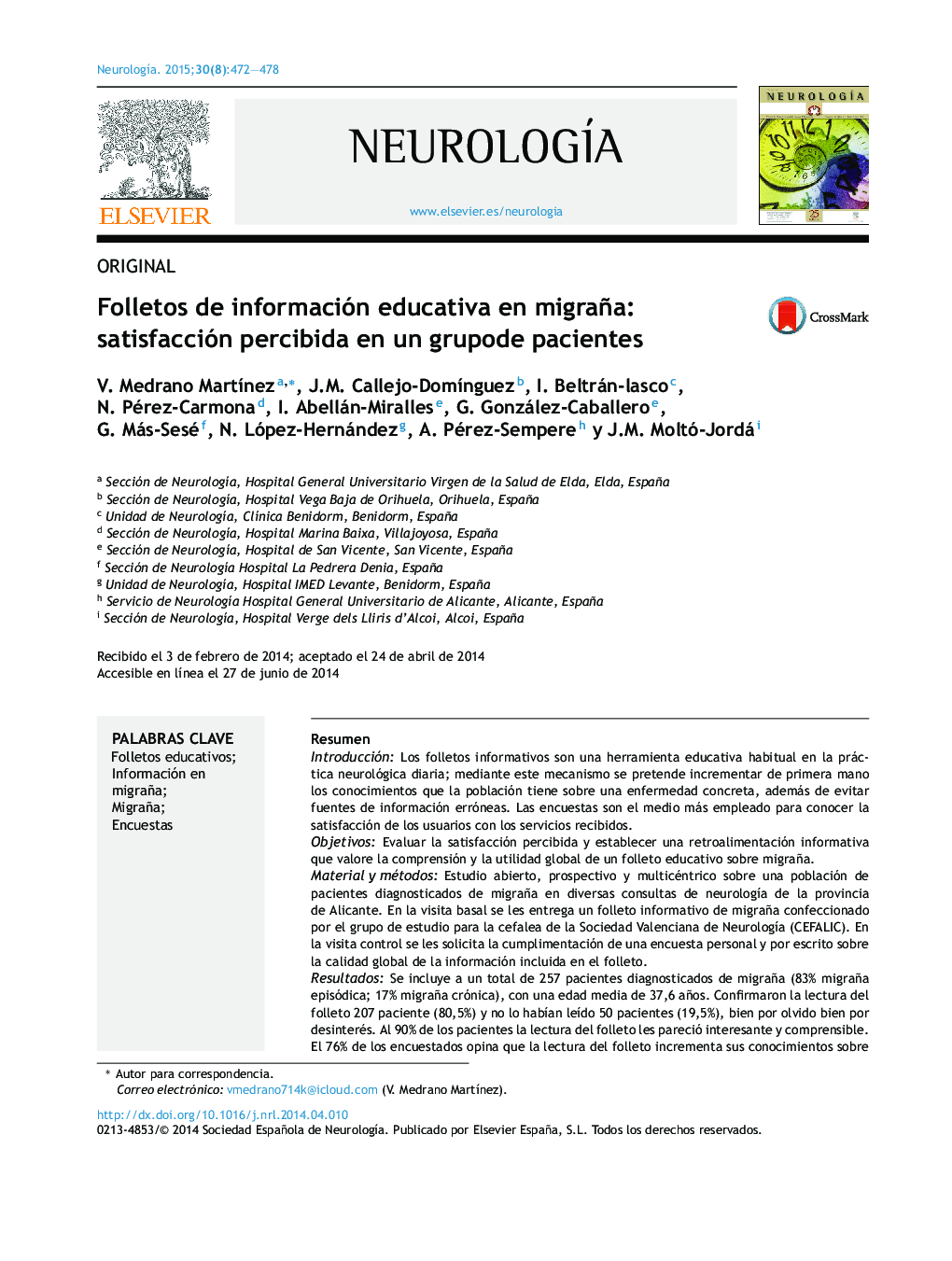| Article ID | Journal | Published Year | Pages | File Type |
|---|---|---|---|---|
| 3075747 | Neurología | 2015 | 7 Pages |
ResumenIntroducciónLos folletos informativos son una herramienta educativa habitual en la práctica neurológica diaria; mediante este mecanismo se pretende incrementar de primera mano los conocimientos que la población tiene sobre una enfermedad concreta, además de evitar fuentes de información erróneas. Las encuestas son el medio más empleado para conocer la satisfacción de los usuarios con los servicios recibidos.ObjetivosEvaluar la satisfacción percibida y establecer una retroalimentación informativa que valore la comprensión y la utilidad global de un folleto educativo sobre migraña.Material y métodosEstudio abierto, prospectivo y multicéntrico sobre una población de pacientes diagnosticados de migraña en diversas consultas de neurología de la provincia de Alicante. En la visita basal se les entrega un folleto informativo de migraña confeccionado por el grupo de estudio para la cefalea de la Sociedad Valenciana de Neurología (CEFALIC). En la visita control se les solicita la cumplimentación de una encuesta personal y por escrito sobre la calidad global de la información incluida en el folleto.ResultadosSe incluye a un total de 257 pacientes diagnosticados de migraña (83% migraña episódica; 17% migraña crónica), con una edad media de 37,6 años. Confirmaron la lectura del folleto 207 paciente (80,5%) y no lo habían leído 50 pacientes (19,5%), bien por olvido bien por desinterés. Al 90% de los pacientes la lectura del folleto les pareció interesante y comprensible. El 76% de los encuestados opina que la lectura del folleto incrementa sus conocimientos sobre migraña. El 50% de los pacientes opina que el folleto resultó de utilidad para mejorar el control de su migraña.ConclusionesLa utilización de un folleto educativo sobre migraña resultó comprensible, además incrementó el conocimiento global de la enfermedad y en opinión de los pacientes resultó útil para mejorar el control de su migraña. La evaluación de la información educativa que prestamos a nuestros pacientes con migraña debe ser medida para descubrir las causas de descontento, determinar el nivel de calidad del servicio e investigar las posibilidades de mejora de calidad.
IntroductionBrochures are commonly used as educational tools in daily neurological practice. They are provided to increase the general population's knowledge of a specific disease and also to combat sources of erroneous information. Surveys are the most commonly used method of ascertaining user satisfaction with services received.ObjectivesThis study will assess patient-perceived satisfaction and provide feedback to measure the comprehensibility and overall utility of an educational brochure on migraine.Material and methodsOpen prospective multicentre study of a group of patients diagnosed with migraine in neurology clinics in Alicante province. During the initial visit, each patient received a migraine brochure prepared by the Valencian Society of Neurology's study group for headaches (CEFALIC). During a follow-up visit, they were then asked to fill out a personal survey on the overall quality of the information in the brochure.ResultsWe included a total of 257 patients diagnosed with migraine (83% episodic migraine; 17% chronic migraine); mean age was 37.6 years. Two hundred seven patients confirmed having read the brochure (80.5%); 50 patients (19.5%) either forgot to read it or had no interest in doing so. The brochure seemed interesting and easy to understand according to 90% of the patients. Seventy-six per cent of the respondents stated that reading the brochure increased their overall knowledge of migraine, while 50% of the patients found the brochure useful for improving migraine control.ConclusionsPatients found the migraine educational brochure to be comprehensible, a means of increasing overall knowledge of the disease, and useful for increasing control over migraines. Evaluations of the educational brochures that we provide to our patients with migraine should be studied to discover the causes of dissatisfaction, determine the level of quality of service, and investigate potential areas for improvement.
